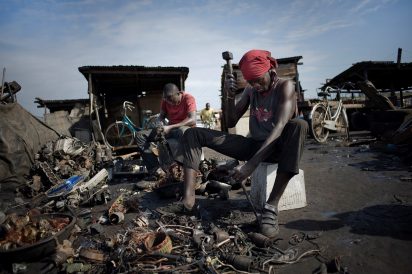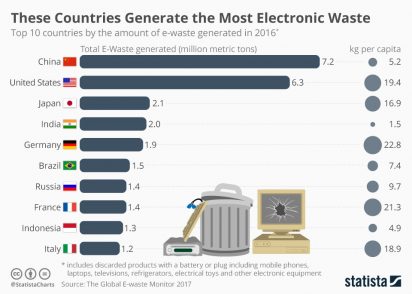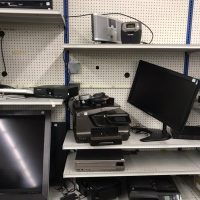E-waste not, want not
Happy launch season!
It’s that time of year again when your favorite tech companies announce new products that make your perfectly good phone from just a year ago feel oppressively obsolete.
This quarter, Apple released a new MacBook Pro; Google flaunted its new line of Pixel smartphones, and Microsoft announced a foldable phone with a physical keyboard. Still waiting for Levi’s to announce compatible 510’s.
If these companies know anything about marketing (hint: they do), you might be planning to upgrade — and that’s fair! As students, teachers, professionals, and human beings, new tech can allow us to analyze data more efficiently, communicate our research in new and innovative ways, and frankly, it’s just fun! But before you backup your info, do your wallet and the planet a favor and ask yourself whether you actually need a new device, and if you do, devise a plan for retiring your current gadget.
According to the UN, somewhere between 20 and 50 million tons of electronic waste (e-waste) are generated each year in the world. On the low end, that’s about equal to 23,121,387,283 Surface Pros, 395,061,728,395 individual or 615,384,615,385 pairs of AirPods. Yikes.
So why is that much e-waste a problem?
It probably goes without saying that a landfill is not the best resting place for your old PC, but in a world where plastic straws and wildfires are trending on Twitter, do we really need to worry about e-waste too? Yes! Here’s why:
Computers, monitors, and smartphones alike are loaded with toxic materials including mercury, brominated flame retardants, and polyvinyl chlorides. These chemicals are hugely problematic for public health due to their persistence and ability to seep into soil, water supplies, and ultimately human and animal bodies.
What’s more, e-waste disproportionately affects individuals and communities that likely never benefited from the product while it was functional. As recently as a decade ago, inmates in US prisons were forced to deconstruct discarded electronics, often without proper protection. Currently, about 80% of the world’s e-waste is still recycled without environmental regulation or worker-protection in developing countries such as Ghana, Nigeria, India, and China. Acid baths and plastic burning wreak havoc on local environments and have been linked to skin, kidney, and respiratory diseases.

What can you do to curb e-waste?
Look, we need technology, so the point of this article is not to give you one more type of waste to worry about — instead, the idea is to get you thinking about every component of your gadgets lifecycles, from the perfectly designed white box to the frayed power adapter you’ve held onto since your high school graduation party. Each piece will have an end, and it’s up to you to decide what that end looks like. The cardboard box is recyclable, but once the cord loses its functionality, what do you do with it? Spoiler alert: it doesn’t belong in any of the bins outside your apartment building!
If you live in Washington State, check out E-Cycle Washington. Through this initiative, the Department of Ecology has diverted 405,372,627 pounds of e-waste from landfills. For those of you still playing along at home, that’s equal to 46,328,300,228 individual, lonely Airpods. However, because the United States is the only industrialized country in the world who has not ratified the Basel Convention on the Control of Transboundary Movements of Hazardous Wastes and their Disposal, there is no guarantee that these so called “recycled” e-waste materials are not getting exported to countries with less restrictive environmental laws and regulations.

While policy, especially in the United States, is not making huge strides in tackling the global e-waste issue, companies have taken initiative to account for their products or offer opportunities to donate to individuals who would benefit from their use. For example, Apple and Goodwill have stepped up their e-recycling game. Folks can take functioning or non-functioning electronics of any make or model to a retail store for resale or recycling (free of charge). In 2018, Apple refurbished more than 7.8 million devices and in the process kept 48,000 metric tons of e-waste out of landfills.
- Don’t need that clunky, mechanical keyboard, old printer, or video games anymore?
- Goodwill can help it find a second life for many of your working electronic devices.
- (Photo credit: Chris Boylan)
Like I said, we’re all human beings and we are all attracted to flashy new products that make 2018 seem antiquated. But before you opt into new tech, ask yourself a couple of questions: Is there anything wrong with your current device? If not, hold onto it until its backlight has dimmed and it’s causing you more trouble than the hefty price tag of a new device is worth. Do you have a plan for your current gadget? If not, consider a few alternatives – whether that’s refurbishing it for your niece’s upcoming birthday or trading it in towards the purchase of a new model. If you absolutely have to have the newest device, consider opting into to something like Apple’s iPhone Upgrade Program. Such customers are free to use and damage their phones as much as they please only to then return the phones to Apple who refurbishes the device or reuses its materials. Android users, your phone carrier probably offers something similar! Lastly, if your “need” is more temporary, for example if you need a portable speaker for your ecopoetics project, don’t buy a whole new product; just borrow one from a loner program like the Student Tech Loan at UW IT. Zero waste and way cheaper too!

Technology will never stop enticing us, but in order to generate less waste (that ultimately someone else will clean up) we need to be diligent consumers and plan for each stage of our products’ life cycles before deciding to upgrade.
Chris Boylan is an Apple employee. However, the views in this article are his own.


